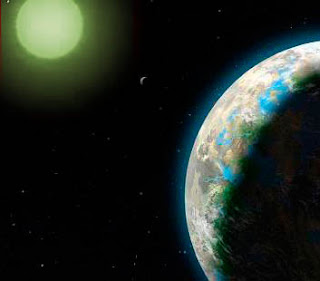 The chances that future generations will one day colonise the stars have just got higher. Astronomers tonight announced the discovery of the most Earth-like planet ever found - a rocky world three times the size of our own world, orbiting a star 20 light years away..
The chances that future generations will one day colonise the stars have just got higher. Astronomers tonight announced the discovery of the most Earth-like planet ever found - a rocky world three times the size of our own world, orbiting a star 20 light years away..The planet lies in the star's 'Goldilocks zone' - the region in space where conditions are neither too hot or too cold for liquid water to form oceans, lakes and rivers.
The planet also appears to have an atmosphere, a gravity like our own and could well be capable of life.
The discovery comes three years after astronomers found a similar, slightly less habitable planet around the same star - described by astronomers as being 'in our backyard' in the Milky Way. Researchers say the findings suggest the universe is teeming with world like our own.
'If these are rare, we shouldn't have found one so quickly and so nearby,' Dr Steven Vogt who led the study at the University of California, Santa Cruz.
'The number of systems with potentially habitable planets is probably on the order of 10 or 20 per cent, and when you multiply that by the hundreds of billions of stars in the Milky Way, that's a large number. There could be tens of billions of these systems in our galaxy.'





No comments:
Post a Comment